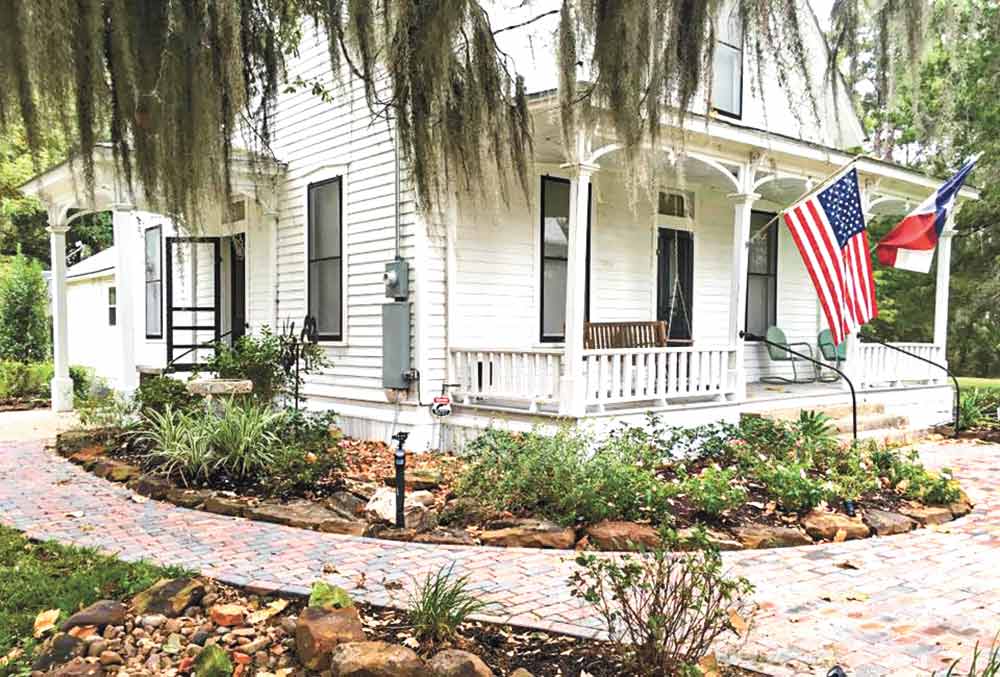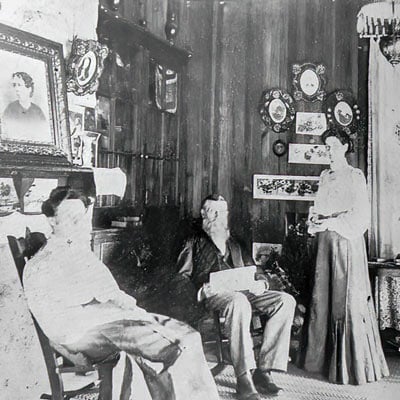The history of the John Henley Hill House

Editor’s note: This is the first of three columns detailing the information surrounding the John Henley Hill House.
The John Henley Hill house and its location is a perfect southern scene of peace and tranquility.
Sitting proudly on a hill, located just a short distance from the town of Trinity, the house is surrounded by giant Southern magnolias, stately oaks, ancient cedars with sphagnum moss hanging from the boughs and crepe myrtles up against a backdrop of pines.
The setting is undoubtedly as it was 135 years ago when it was built and landscaped.
There is evidence that a red brick drive meandered from the road to the house, which must have been an impressive site. The integrity of the property and home has been maintained for over a century. The home, built in 1880 by John Henley Hill, as it stands now, is a near perfect example of simple style, elegance and historical integrity.
In the late 1860s and 1870s the town of Trinity was beginning to show signs of growth. Promoted by the building of the International and Great Northern Railroad in 1872, and huge land prospects of virgin timber, Trinity was a hub of a growing commerce.
Farming still was prominent in the outlying areas with farmers using the Trinity River for navigating shipments of cotton and crops to Galveston. When the rail was finished from Houston to Palestine, farmers and merchants were able to ship via the railways and river navigation began to decline.
In the 1870s, after the Civil War, the old plantation owners of the farmlands began selling off their vast property holdings.
Trinity served as the county seat from 1873 through 1874 and it was then that residents elected to move the county seat to Pennington. Sumpter, Trinity County’s first county seat, from 1852 through 1873, began to decline after 1873, and many of its prominent citizens moved to Trinity for the advantage of railroad and commerce.
The first Post Office in Trinity was established Feb. 28, 1872, with Sam. T. Robb as postmaster. Robb, a lawyer and early settler in the town of Sumpter, had moved to Trinity by 1872. In viewing Trinity County Deed records from 1876 to present it is obvious that Robb was also in the business of buying and selling land.
In the early development of what is now Trinity County, there were several large plantation owners who had migrated west to Texas from the Old South. The lands along the Trinity River were cleared by hundreds of slaves for the benefit of cotton and crop production. Before the railroad was built in 1872, the primary means of shipping crops to market was the Trinity River.
The Hill house sits on one of the earliest plantation sites located in the Elisha Roberts Survey. Roberts, a wealthy slave owner from Kentucky, came to Texas in 1824, settling in San Augustine. He acquired the earliest Mexican land grant in 1831 for 4,428 acres of land in what is now known as Trinity County.
When he died in 1845 the 4428 acres located here in Trinity County, was inherited by his four daughters, Ester Jane Roberts Sublett, Margaret Roberts McDonald, Mahala Roberts Sharp Hall and Ann Roberts Doughtry. Ester Sublett and Margaret McDonald, both widows by 1851, bought out their sister’s 1,107-acre parcels in 1854.
Ester Sublett owned the west half and Margaret McDonald owned the east half of the original survey fora total of 2,214 acres of land for each of the women. A receipt found in the Elisha Roberts Probate dated February 1846, states:
Huntsville, 3 February 1846
$138.57
… please pay A.M. McDonald (Alexander McDonald, husband Of Margaret McDonald) One Hundred and Thirty Eight 57/100 Dollars for supplies furnished to the Trinity Plantation.
R. Hannay
 John Hill purchased 200 acres from S.T. Robb and began construction on this house for his family. The John Henley Hill House is located at 2005 Pinecrest Road in Trinity. From the town of Trinity, go south on State Highway 19 to East Tatum Street, Turn left (east) go 2/10 mile to Pinecrest Road, turn right (south) and go 9/10 mile to driveway entrance on left. COURTESY PHOTOSAnother receipt found in the probate files reads:
John Hill purchased 200 acres from S.T. Robb and began construction on this house for his family. The John Henley Hill House is located at 2005 Pinecrest Road in Trinity. From the town of Trinity, go south on State Highway 19 to East Tatum Street, Turn left (east) go 2/10 mile to Pinecrest Road, turn right (south) and go 9/10 mile to driveway entrance on left. COURTESY PHOTOSAnother receipt found in the probate files reads:
“Rec’d of Noel Roberts as one of the Executors of E. Roberts, deceased, five dollars for advertizing the Trinity place for rent this 1 March 1848. Signed H.W. Sublett
These receipts indicate that there was, in the 1840s, a plantation on the Elisha Roberts survey in operation. It is not known where the residence was located on the 4428 acres. The history of Elisha Roberts and his daughters Ester Sublett and Margaret McDonald has an incredible history and legacy.
The Roberts and Sublett families have early Texas history connections in Texas independence. Ester Sublett is shown in 1860 U.S. Federal Census records as residing in San Augustine, San Augustine County, Texas, with her three sons, Franklin, Phillip A. (Jr.) and Henry W. She has a property value in that county of and a personal property value of $35,940.
The 1860 Federal Slave Schedule for San Augustine County shows Mrs. Sublett as owning 22 slaves at that time. She had inherited 23 slaves from her father’s estate in the 1850s.
The U.S. Federal Census of 1860 for Trinity County reveals that F.B. (Franklin Bolivar) Sublett, age 30, declared he was a “Planter” with a real estate value of $80,000, and a personal estate value of $90,000. In the same household is shown: J.V. (Josephus) Brooks, Farmer, age 23, also with a personal property value of $6,000, E.J. Sublet (Ester Jane), age 47, P.A. Sublett (Phillip, age 18, and H.W. Sublett, age 15).
The 1860 US Federal Slave Schedule for Trinity County shows F.B. Sublett enumerated as owning 113 slaves in Trinity County and is the largest slave owner in the county. Josephus (Joseph) Brooks was an overseer for the Sublett plantation from about 1859 through about 1861.
In his account of the plantation he mentions Mrs. Sublett visiting the plantation several times. Franklin Bolivar Sublett’s dies in 1866 and in 1870, Ester Sublett leases the property to her next oldest son Phillip for $1,000 in gold coin, for a period of one year.
It was this Phillip A. Sublett, Jr. who shot John Wesley Hardin in Trinity in 1872, and he too dies as a young man in 1873.
In June of 1877, Ester Sublett sells her 1,107 acres out of the Elisha Roberts Survey to Sam T. Robb, longtime resident of Trinity County.
In 1880, Mr. Robb sells a 200-acre parcel of that same land to John Henley Hill.
Compiled by Susanne Waller of the Trinity County Historical Commission.
You are a guest
or post as a guest
Be the first to comment.

